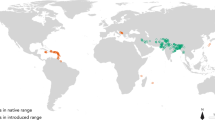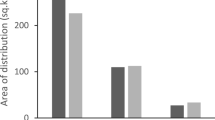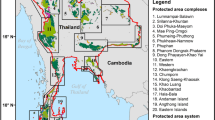Abstract
Five species of mouse or forest shrews (Myosorex) are endemic to South Africa, Lesotho and Swaziland, four of which (Myosorex varius, Myosorex cafer, Myosorex longicaudatus and Myosorex cf. tenuis) are associated with montane or temperate grassland, fynbos and/or forest habitats while a fifth (Myosorex sclateri) is associated with lowland subtropical forests. Due to their small size, specialised habitat, low dispersal capacity, high metabolism and sensitivity to temperature extremes, we predicted that, particularly for montane species, future climate change should have a negative impact on area of occupancy (AOO) and ultimately extinction risks. Species distribution models (SDMs) indicated general declines in AOO of three species by 2050 under the A1b and A2 climate change scenarios (M. cafer, M. varius, M. longicaudatus) while two species (M. sclateri and M. cf. tenuis) remained unchanged (assuming no dispersal) or increased their AOO (assuming dispersal). While temperate species such as M. varius appear to be limited by temperature maxima (preferring cooler temperatures), the subtropical species M. sclateri appears to be limited by temperature minima (preferring warmer temperatures). Evidence for declines in AOO informed the uplisting (to a higher category of threat) of the Red List status of four Myosorex species to either vulnerable or endangered as part of a separate regional International Union for Conservation of Nature (IUCN) Red List assessment.




Similar content being viewed by others
References
Anderson RP, Raza A (2010) The effect of the extent of the study region on GIS models of species geographic distributions and estimates of niche evolution: preliminary tests with montane rodents (genus Nephelomys) in Venezuela. J Biogeogr 37:1378–1393. doi:10.1111/j.1365-2699.2010.02290.x
Baxter RM (2008a) Myosorex cafer. IUCN Red List of Threatened species. Version 2010.4. www.iucnredlist.org. Accessed 29 Dec 2012
Baxter RM (2008b) Myosorex longicaudatus. IUCN 2012 Red List of Threatened species. Version 2010.4. www.iucnredlist.org. Accessed 29 Dec 2012
Baxter RM (2008c) Myosorex sclateri. IUCN Red List of Threatened species. Version 2010.4. www.iucnredlist.org. Accessed 29 Dec 2012
Baxter RM (2008d) Myosorex varius. IUCN RedList of Threatened species. Version 2010.4. www.iucnredlist.org. Accessed 29 Dec 2012
Baxter RM, Dippenaar NJ (2013a) Myosorex cafer Dark footed mouse shrew. In: Happold M, Happold DC (eds) Mammals of Africa, Hedgehogs, shrews and bats, vol IV. Bloomsbury, London, pp. 152–153
Baxter RM, Dippenaar NJ (2013b) Myosorex varius Forest shrew. In: Happold M, Happold DCD (eds) Mammals of Africa, Hedgehogs, shrews and bats, vol IV. Bloomsbury, London, pp. 161–163
Baxter R, Willows-Munro S, Taylor PJ (2016) A conservation assessment of Myosorex longicaudatus. In: Child MF, Raimondo D, Do Linh San E, Roxburgh L, Davies-Mostert H (eds) The red list of mammals of South Africa, Swaziland and Lesotho. South African National Biodiversity Institute and Endangered Wildlife Trust, South Africa
Beaumont LJ, Hughes L, Pitman AJ (2008) Why is the choice of future climate scenarios for species distribution modelling important? Ecol Lett 11:1135–1146. doi:10.1111/j.1461-0248.2008.01231.x
Blackburn DC, Gvoždík V, Leaché AD (2010) A new squeaker frog (Arthroleptidae: Arthroleptis) from the mountains of Cameroon and Nigeria. Herpetologica 66:335–348. doi:10.1655/HERPETOLOGICA-D-10-00015.1
Bomhard B, Richardson DM, Donaldson JS, Hughes GO, Midgley GF, Raimondo DC, Rebelo AG, Rouget M, Thuiller W (2005) Potential impacts of future land use and climate change on the Red List status of the Proteaceae in the Cape Floristic Region, South Africa. Global Change Biology 11(9):1452–1468
Bowie RCK, Fjeldsa J, Hackett SJ, Bates JM, Crowe TM (2005) Coalescent models reveal the relative roles of ancestral polymorphism, vicariance, and dispersal in shaping phylogeographical structure of an African montane forest robin. Mol Phylogenet Evol 38:171–188
Brown JL (2014) SDMtoolbox: a python-based GIS toolkit for landscape genetic, biogeographic and species distribution model analyses. Methods Ecol Evol
Brown CR, Hunter EM, Baxter RM (1997) Metabolism and thermoregulation in the forest shrew Myosorex varius (Soricidae: Crocidurinae). Comp Biochem Phys A 118:1285–1290. doi:10.1016/S0300-9629(97)00223-5
Child MF, Raimondo D, Do Linh San E, Roxburgh L, Davies-Mostert H (2016) The red list of mammals of South Africa, Swaziland and Lesotho. South African National Biodiversity Institute and Endangered Wildlife Trust, South Africa
Chown SL, Hoffmann AA, Kristensen TN, Angilletta MJ, Stenseth NC, Pertoldi C (2010) Adapting to climate change: a perspective from evolutionary physiology. Clim Res 43:3–15. doi:10.3354/cr00879
Churchfield S (2013) Family Soricidae shrews. In: Happold M, Happold DCD (eds) Mammals of Africa, Hedgehogs, shrews and bats, vol IV. Bloomsbury, London, pp. 43–50
Coetzee BWT, Robertson MP, Erasmus BFN, van Rensburg BJ, Thuiller W (2009) Ensemble models predict important bird areas in southern Africa will become less effective for conserving endemic birds under climate change. Glob Ecol Biogeogr 18:701–710. doi:10.1111/j.1466-8238.2009.00485.x
Davis CL (2011) Climate risk and vulnerability: a handbook for southern Africa. Council for Scientific and Industrial Research, Pretoria
Dippenaar NJ (1995) Geographic variation in Myosorex longicaudatus (Soricidae) in the southern Cape Province, South Africa. J Mammal 76:1071–1087
Dippenaar NJ, Baxter RM (2013) Myosorex longicaudatus long-tailed mouse shrew. In: Happold M, Happold DCD (eds) Mammals of Africa, Hedgehogs, shrews and bats, vol IV. Bloomsbury, London, pp. 156–157
Driver A, Sink KJ,Nel JL, Holness SH, Van Niekerk L, Daniels F, Jonas Z, Majiedt PA, Harris L, Maze K (2012) National Biodiversity Assessment 2011: an assessment of South Africa’s biodiversity and ecosystems. Synthesis report. South African National Biodiversity Institute and Department of Environmental Affairs, Pretoria
Eastman LM, Morelli TL, Rowe KC, Conroy CJ, Moritz C (2012) Size increase in high elevation ground squirrels over the last century. Glob Chang Biol 18:1499–1508. doi:10.1111/j.1365-2486.2012.02644.x
Elith J, Leathwick JR (2009) Species distribution models: ecological explanation and prediction across space and time. Annu Rev Ecol Evol S 40:677–697. doi:10.1146/annurev.ecolsys.110308.120159
Elith J et al. (2006) Novel methods improve prediction of species’ distributions from occupancy data. Ecography 29:129–151
Elith J, Phillips SJ, Hastie T, Dudík M, Chee YE, Yates CJ (2011) A statistical explanation of MaxEnt for ecologists. Divers Distrib 17:43–57. doi:10.1111/j.1472-4642.2010.00725.x
Erasmus BFN, Van Jaarsveld AS, Chown SL, Kshatriya M, Wessels KJ (2002) Vulnerability of South Africa animal taxa to climate change. Glob Chang Biol 8:679–693
Freeman EA, Moisen GG (2008) A comparison of the performance of threshold criteria for binary classification in terms of predicted prevalence and kappa. Ecol Model 217:48–58
García-Domínguez JA, Rojas-Soto OR, Galindo-González JR, González-Romero A, del Rosario P-LM, Noa-Carrazana JC (2014) Present and future potential distribution of the endemic Perote ground squirrel (Xerospermophilus perotensis) under different climate change scenarios. Mammalia:1–15. doi:10.1515/mammalia-2013-0077
Genoud M (1988) Energetic strategies of shrews: ecological constraints and evolutionary implications. Mammal Rev 18:173–193
Hannah L, Midgley G, Hughes G, Bomhard B (2005) The view from the cape: extinction risk, protected areas, and climate change. Bioscience 55:231–242. doi:10.1641/0006-3568(2005)055[0231:tvftce]2.0.co;2
Hughes L (2000) Biological consequences of global warming: is the signal already apparent? Trends Ecol Evol 15:56–61. doi:10.1016/S0169-5347(99)01764-4
Hughes GO, Thuiller W, Midgley GF, Collins K (2008) Environmental change hastens the demise of the critically endangered riverine rabbit (Bunolagus monticularis). Biol Conser 141:23–34. doi:10.1016/j.biocon.2007.08.004
Hutterer R (2013) Genus Myosorex mouse shrews. In: Happold M, Happold DCD (eds) Mammals of Africa, Hedgehogs, shrews and bats, vol IV. Bloomsbury, London, pp. 149–150
IPCC (2007) Climate change 2007: synthesis report. In: Core Writing Team, Pachauri RK, Reisinger A (eds) Contribution of working groups I, II and III to the fifth assessment report of the intergovernmental panel on climate change. IPCC, Geneva, Switzerland, p. 104
IPCC (2014) In: Core Writing Team, Pachauri RK, Meyer LA (eds) Climate change 2014: synthesis report. Contribution of working groups I, II and III to the fourth assessment report of the intergovernmental panel on climate change. IPCC, Geneva, Switzerland 151 pp
IUCN (2012) IUCN red list categories and criteria, version 3.1, second edn. International Union for Conservation of Nature, Gland, Switzerland
IUCN Standards and Petitions Subcommittee (2014) Guidelines for Using the IUCN Red List Categories and Criteria. Version 11. Prepared by the Standards and Petitions Subcommittee. Downloadable from http://www.iucnredlist.org/documents/RedListGuidelines.pdf
Jenkins PD, Churchfield S (2013a) Myosorex sclateri. Sclater's mouse shrew. In: Happold M, Happold DCD (eds) Mammals of Africa, volume IV: hedgehogs, shrews and bats. Bloomsbury, London, pp. 159–160
Jenkins PD, Churchfield S (2013b) Myosorex tenuis. Thin mouse shrew (Transvaal Forest shrew). In: Happold M, Happold DCD (eds) Mammals of Africa, volume IV: hedgehogs, shrews and bats. Bloomsbury, London, pp. 160–161
Kriticos DJ, Webber BL, Leriche A, Ota N, Macadam I, Bathols J, Scott JK (2012) ) CliMond: global high-resolution historical and future scenario climate surfaces for bioclimatic modelling. Methods Ecol Evol 3:53–64
Kruger AC, Shongwe S (2004) Temperature trends in South Africa: 1960-2003. Int J Climatol 24:1929–1945. doi:10.1002/joc.1096
Lawson LP, Bates JM, Menegon M, Loader SP (2015) Divergence at the edges: peripatric isolation in the montane spiny throated reed frog complex. BMC Evolutionary Biology 15(1):128
Maclean IMD, Wilson RJ (2011) Recent ecological responses to climate change support predictions of high extinction risk. Proceedings of the National Academy of Sciences 108(30):12337–12342
McCain CM, Colwell RK (2011) Assessing the threat to montane biodiversity from discordant shifts in temperature and precipitation in a changing climate. Ecol Lett 14:1236–1245. doi:10.1111/j.1461-0248.2011.01695.x
Meester JAJ, Rautenbach IL, Dippenaar NJ, Baker CM (1986) Classification of southern African mammals. Transv Mus Monogr 5:1–359
Midgley GF, Hughes GO, Thuiller W, Rebelo AG (2006) Migration rate limitations on climate change-induced range shifts in cape Proteaceae. Divers Distrib 12:555–562. doi:10.1111/j.1366-9516.2006.00273.x
Monadjem A, Virani MZ, Jackson C, Reside A (2012) Rapid decline and shift in the future distribution predicted for the endangered Sokoke Scops owl Otus ireneae due to climate change. Bird Conserv Int 23:247–258. doi:10.1017/s0959270912000330
Mucina L, Rutherford MC (2006) The vegetation of South Africa, Lesotho and Swaziland. Strelitzia 19:1–807
Nemakhavhani T (2014) Spatial and reproductive differentiation of small terrestrial mammals in a complex environment in the western Soutpansberg Mountain, Limpopo province. MSc dissertation, University of Venda
Nengovhela A, Baxter RM, Taylor PJ (2015) Temporal changes in cranial size in south African vlei rats (Otomys): evidence for the ‘third universal response to warming’. Afr Zool 50:233–239
Parmesan C (2006) Ecological and evolutionary responses to recent climate change. Annu Rev Ecol Evol S 37:637–669. doi:10.1146/annurev.ecolsys.37.091305.110100
Phillips SJ, Dudík M (2008) Modeling of species distributions with Maxent: new extensions and a comprehensive evaluation. Ecography 31:161–175
Phillips SJ, Anderson RP, Schapire RE (2006) Maximum entropy modeling of species geographic distributions. Ecol Model 190:231–259
Pio DV et al. (2014) Climate change effects on animal and plant phylogenetic diversity in southern Africa. Glob Chang Biol 20:1538–1549. doi:10.1111/gcb.12524
Sikes RS, Gannon WL, the Animal Care and Use Committee of the American Society of Mammalogists. 2011. Guidelines of the American Society of Mammalogists for the use of wild mammals in research. J Mammal 92:235–253
Simmons RE, Barnard P, Dean WRJ, Midgley GF, Thuiller W, Hughes G (2004) Climate change and birds: perspectives and prospects from southern Africa. Ostrich 75:295–308
Sparti A (1990) Comparative temperature regulation of African and European shrew. Comp Biochem Phys A 97:391–397. doi:10.1016/0300-9629(90)90629-7
Stanley WT, Esselsteyn JA (2010) Biogeography and diversity among montane populations of mouse shrew (Soricidae: Myosorex) in Tanzania. Biol J Linn Soc 100:669–680
Stanley WT, Hutterer R (2000) A new species of Myosorex gray, 1832 (Mammalia: Soricidae) from the eastern Arc Mountains, Tanzania. Bonn zool Beitr 49:19–29
Taylor PJ et al. (2009) Speciation mirrors geomorphology and palaeoclimatic history in African laminate-toothed rats (Muridae: Otomyini) of the Otomys denti and Otomys lacustris species-complexes in the ‘montane circle’ of East Africa. Biol J Linn Soc 96:913–941. doi:10.1111/j.1095-8312.2008.01153.x
Taylor PJ, Lavrenchenko LA, Carleton MD, Verheyen E, Bennett NC, Oosthuizen CJ, Maree S (2011) Specific limits and emerging diversity patterns in East African populations of laminate-toothed rats, genus Otomys (Muridae: Murinae: Otomyini): revision of the Otomys typus complex. Zootaxa 1–66
Taylor PJ, Stoffberg S, Monadjem A, Schoeman MC, Bayliss J, Cotterill FPD (2012) Four new bat species (Rhinolophus hildebrandtii Complex) reflect Plio-Pleistocene divergence of dwarfs and giants across an Afromontane archipelago. PLoS One 7. doi:10.1371/journal.pone.0041744
Taylor PJ, Kearney TC, Kerbis Peterhans JC, Baxter RM, Willows-Munro S (2013) Cryptic diversity in forest shrews of the genus Myosorex from southern Africa, with the description of a new species and comments on Myosorex tenuis. Zool J Linn Soc-Lond 169:881–902. doi:10.1111/zoj.12083
Taylor PJ, Munyai A, Gaigher I, Baxter R (2014) Afromontane small mammals do not follow the hump-shaped rule: altitudinal variation in the Soutpansberg Mountains, South Africa. J Trop Ecol 31:37–48. doi:10.1017/s0266467414000613
Taylor PJ, Nengovhela A, Linden J, Baxter RM (2015) Past, present, and future distribution of Afromontane rodents (Muridae: Otomys) reflect climate-change predicted biome changes. Mammalia. doi:10.1515/mammalia-2015-0033
Thomas CDCA, Green RE, Bakkenes M, Beaumont LJ, Collingham YC, Erasmus BFN, de Siqueira MF, Grainger A, Hannah L, Hughes L, Huntley B, van Jaarsveld AS, Midgley GF, Miles L, Ortega-Huerta MA, Peterson AT, Phillips OL, Williams SE (2004) Extinction risk from climate change. Nature 427:145–148
Thuiller W, Broennimann O, Hughes G, Alkemade JRM, Midgley GF, Corsi F (2006) Vulnerability of African mammals to anthropogenic climate change under conservative land transformation assumptions. Glob Chang Biol 12:424–440. doi:10.1111/j.1365-2486.2006.01115.x
Tshiala MF, Olwoch JM, Engelbrecht FA (2011) Analysis of temperature trends over Limpopo Province, South Africa. JGG 3:13–21. doi:10.5539/jgg.v3n1p13
Van Der Wal JSLP, Graham C, Williams SE (2009) Selecting pseudo-absence data for presence-only distribution modeling: how far should you stray from what you know? Ecol Model 220:589–594. doi:10.1016/j.ecolmodel.2008.11.010
Willows-Munro S, Matthee CA (2011) Linking lineage diversification to climate and habitat heterogeneity: phylogeography of the southern African shrew Myosorex varius. J Biogeogr 38:1976–1991. doi:10.1111/j.1365-2699.2011.02543.x
Acknowledgments
This paper is dedicated to our colleague, the late Roderick M. Baxter, who passed away tragically during the writing of this paper. PJT acknowledges the financial support of the University of Venda, the National Research Foundation and the Department of Science and Technology under the South African Research Chair Initiative (SARChI) on Biodiversity Value and Change within the Vhembe Biosphere Reserve hosted at University of Venda and co-hosted by the Centre for Invasion Biology at University of Stellenbosch. Mark Robertson provided very valuable advice on MaxEnt modelling aspects.
Author information
Authors and Affiliations
Corresponding author
Additional information
Communicated by: Quinn Fletcher
Electronic supplementary material
Supplementary Fig. 1
(Maps of South Africa showing the distribution of maximum temperatures of the warmest month (Bioclim variable 5) based on current data (a) and predicted for 2050 (b), overlaid with the distribution range of M. varius (crosses). DOCX 417 kb)
Supplementary Fig. 2
(Maps of South Africa showing the distribution of precipitation of the wettest month (Bioclim variable 13) based on current data (a) and predicted for 2050 (b), overlaid with the distribution range of M. cf. tenuis (red filled squares). DOCX 259 kb)
Rights and permissions
About this article
Cite this article
Taylor, P.J., Ogony, L., Ogola, J. et al. South African mouse shrews (Myosorex) feel the heat: using species distribution models (SDMs) and IUCN Red List criteria to flag extinction risks due to climate change. Mamm Res 62, 149–162 (2017). https://doi.org/10.1007/s13364-016-0291-z
Received:
Accepted:
Published:
Issue Date:
DOI: https://doi.org/10.1007/s13364-016-0291-z




